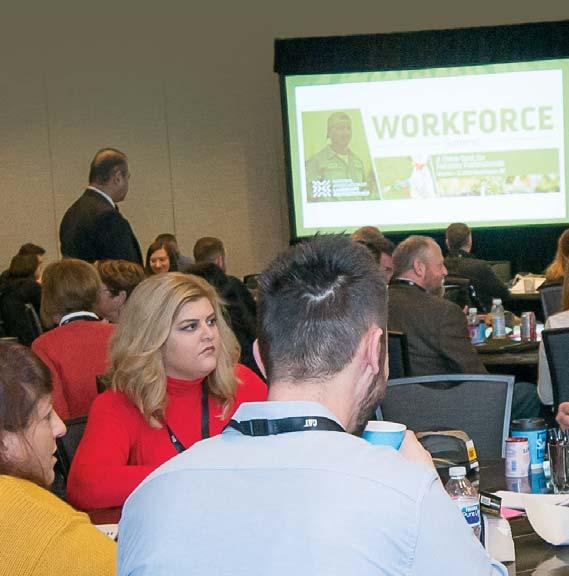
6 minute read
NALP Experience: Workforce
THE NALP EXPERIENCE
Workforce Summit Highlights Ways to Attract and Retain Employees
Advertisement

By Jill Odom

MORE THAN 100 INDUSTRY MEMBERS
gathered in Alexandria, Virginia on March 2-3 for this year’s Workforce Summit to share strategies and best practices on attracting and retaining workers. If you were unable to attend this year’s summit, here’s an overview of some of the topics that were discussed.


ATTRACTING
If you ask your peers in the industry what is one of their biggest pain points, majority will say it is finding labor. With this being such a common issue, you have to get creative with where you’re looking for potential employees and how you are attracting them to your company.
DEVELOP MORE DIVERSITY
The first step to attracting a more diverse workforce is to ensure your company culture is open and inclusive. For instance, if you are looking to attract more women to the field, work on having the basics taken care of such as providing uniforms and PPE specifically designed for women and ensuring access to bathrooms. Training on anti-bullying and sexual harassment policies should also be created.
“There was tremendous insight on how to create a culture of diversity and inclusion in the workplace and steps you can take to walk the talk,” says PJ Rovinelli Jr., director of talent development at Ewing Irrigation and Landscape Supply.
Another demographic you can look to tap into is the up and coming Gen Z, which are those born in 1998 or later. Employees in this age group want to know about their impact on the environment and are very inclusive when it comes to diversity in general. People in this generation are looking for clear growth paths and are open to careers right after high school, so they should be recruited early on.
EFFECTIVE INDUSTRY BRANDING
One major element that is keeping people from considering landscaping
As for engaging with local FFA chapters, focus on educating the educators as you start to reach out. Offer a helping hand to the teachers who are stretched thin by providing hands-on experiences for these students. FFA students have strong value systems and great soft skills, making them a good fit for the industry.
and lawn care jobs as a career is the general perception of the industry.
“A rebrand of our industry is required to attract new and future generations to our awesome industry,” Rovinelli says. “We are far more than a ‘mow and blow’ workforce.”
Rovinelli advises sharing the passion, ideas and concepts of sustainable solutions and environmental resource management.
Some of the ways you can communicate the value of a job in the green industry is to partner with local schools, local FFA chapters and workforce development boards.
While collaborating with schools can take a lot of work, you will also reap the benefits. It is important to be strategic about how you want to recruit and provide real-world experience to the students.
Rovinelli says Ewing is looking into ways to work collaborate with local schools and organizations to introduce and share their passion for the work they do.
“The earlier we expose our community to the work we do the greater influence we can have!” he says.
As for engaging with local FFA chapters, focus on educating the educators as you start to reach out. Offer a helping hand to the teachers who are stretched thin by providing hands-on experiences for these students. FFA students have strong value systems and great soft skills, making them a

“The group is stronger because everyone has the same challenges and are willing to come together, share and be open to possibilities.” - Scott Sittler, channel marketing manager, Husqvarna
good fit for the industry.
“I was in a group that spent a lot of time discussing how to engage students involved in FFA,” says Erin Barr, director of human resources operations for Munie Greencare Professionals, based in Caseyville, Illinois. “We had some really great ideas and were able to get into details about how to engage students in general.”
Participating in and creating a presence at workforce development boards can put you in contact with like-minded employers who are dealing with similar recruiting issues. It brands you with the community and provides a consistent flow of candidates from the workforce board. This can also put you in contact with others who can help supply you with candidates.
“Right after the conference I started reaching out to local workforce boards and have partnered with several in different locations where we have an office,” Barr says. “Some of our plans have been put on hold due to the current situation with COVID-19, but we want to continue to build on our current programs and implement the apprenticeship program.”
The Landscape Management Apprenticeship Program was launched at last year’s Workforce Summit Continued on page 12 Ð


“Eric Chester’s keynote presentation was fantastic. His advice around creating a great work environment was the most beneficial.” - Scott Sittler, channel marketing manager, Husqvarna

and offers job seekers a new career path via a paid apprenticeship with a professional landscape company. As an apprenticed industry, the landscape profession is now considered a skilled trade.
Apprentices are required to receive 2,000 hours of on-the-job training as well as a minimum of 144 hours of in the classroom or online equivalent.
Barr says she was very curious to hear during this summit how companies were implementing the program.
“When I first heard about it in 2019, I had a hard time envisioning how we could implement it and make it work,” she says. “After hearing about the successes of other companies and how they put it to use in a practical sense, it really helped me frame it in my mind and understand how we could move forward with it.”
RETAINING
After you’ve went above and beyond recruiting your employees, the last thing you want to do is to lose them over not having a company culture that makes them want to stay. Starting with improved onboarding can help new employees feel welcomed from day one. Some of the ways to achieve this is to assign a mentor to a new employee from the start and allowing them to anonymously submit feedback. Make sure your new hires understand your core values and how you implement them on a daily basis.
Celebrate employees’ accomplishments and recognize them on social media. One way to develop a positive culture is to create an awards program where individuals can recommend other employees for awards.
Another aspect of a strong company culture is to invest in educating and training staff. This will not only attract new recruits but shows current employees how much you value you them and your desire for them to continually improve.
In the same vein of providing employees opportunities to improve, offering a visible career ladder is also critical for both prospects and staff. Highlight how a person can reach a certain job position while understanding not everyone progresses on a set path. Also there are people who don’t want to be promoted to a different type of job.
In employee reviews, make a point to monitor and document employees’ core competencies to see how people are doing overall. TLP









